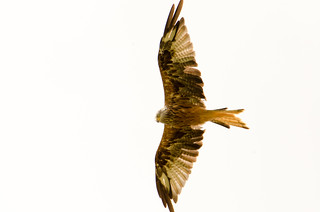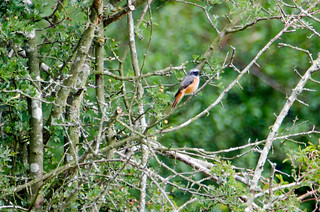We started with an early breakfast at the East Hook Farmhouse B&B where we were staying, then off to the RNLI Lifeboat Station at St Justinians, near St. Davids.
Our boat left for Ramsey (Ynys Dewi) at 10.00am and was packed. The sun was our, there wasn't much of a breeze, and the crossing was easy. Such a change from the day before (and the day after). On landing we had a brief talk from the RSPB volunteers, mainly about the key species and the options for trails. With only one toilet on the island, and everyone there carrying binoculars and cameras, everyone opted to go for a visit before setting off - a queue for the ladies as usual.
We opted for the north circuit as we could then decide on 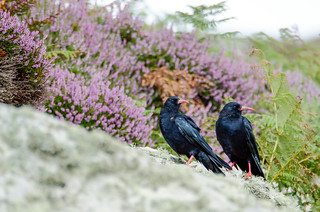 progress as to whether to loop round on the south circuit later - we had a 2.30pm boat to catch for our visit to Grassholm. Soon after we set out we had our first tick; a number of chough [151] were feeding in the fields but remained at arms length. Good numbers of wheatear showed as we walked parallel to the perimeter wall. We had considered not climbing to Cam Ysguabor but when we got there we decided to make the ascent. To the right I saw stonechat and amongst the usual butterflies, I added Wall. We started to really appreciate the views afforded from the tor.
progress as to whether to loop round on the south circuit later - we had a 2.30pm boat to catch for our visit to Grassholm. Soon after we set out we had our first tick; a number of chough [151] were feeding in the fields but remained at arms length. Good numbers of wheatear showed as we walked parallel to the perimeter wall. We had considered not climbing to Cam Ysguabor but when we got there we decided to make the ascent. To the right I saw stonechat and amongst the usual butterflies, I added Wall. We started to really appreciate the views afforded from the tor.
We dropped back down to Aber Mawr and from  here watched ravens, fulmar [152], chough and herring gulls soar around the cliffs. Common seals also swam in the shallows below.
here watched ravens, fulmar [152], chough and herring gulls soar around the cliffs. Common seals also swam in the shallows below.
We continued along the trail and at the foot of the hill to Carn Llundain we stopped to eat our sandwich lunch. Wheatears and meadow pipit flew around us; the occasional chough soared by, usually calling loudly.
As we reached Porth Lleuog, Charlotte and Ailsa opted to take the short cut back across to the harbour for a cup of tea while Eilidh and I continued onto the south circuit; that decision was proved to be the correct one when we approached the bay across to Ynys Gwelltog - what a sight! We had more views of wheatear, mipits and chough plus an increasing number of butterflies including gatekeeper and common blue.
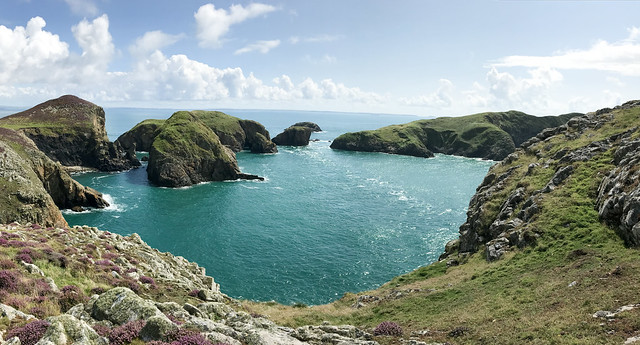
We turned for the harbour passing Foel Fawr hoping to see the harbour porpoises that are sometimes views from this stretch, but without success.
We met up with the others at the farmhouse and shop, and waited for our next ride to arrive. Just a few minutes late we climbed onto our jet boat which was due to take us out to RSPB Grassholm, some 7.5 miles offshore. Nice and steady as we started out on 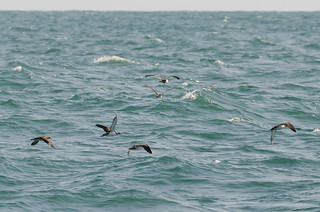 Ramsey Sound but as we accelerated into the now stiffening breeze, we started bouncing in our seats as we hit each wave; the water often blowing directly into us as we landed - I'm not sure this was Eilidh or Ailsa's favourite bit.
Ramsey Sound but as we accelerated into the now stiffening breeze, we started bouncing in our seats as we hit each wave; the water often blowing directly into us as we landed - I'm not sure this was Eilidh or Ailsa's favourite bit.
As we got further out to sea we started to see groups on manx shearwater - on occasions they flew alongside the boat and it was tempting to take a photo - not really possible due the motion of the boat. We also picked out some guillemot and common tern. As we approached Grassholm the numbers of gannets grew - we then talked with our crew and were told that around 39,000 pairs of gannet bred on the island this year and that the numbers keep growing. We also saw good numbers of kittiwake on the cliffs.
We circled the island and on the far side we came across some shag; 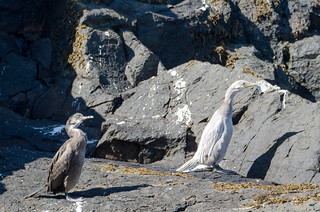 one of these, in amongst the juvenile group was an albino, something our crew said they hadn't seen before.
one of these, in amongst the juvenile group was an albino, something our crew said they hadn't seen before.
Finishing up at Grassholm we started back but soon came to a stop as we came across a group of common dolphins. They swan around the boat but as we left they unfortunately didn't follow in the bow-wave. The journey back was much smoother and it was possible to stand for some of the way. Along with the manx shearwater were increasing numbers of guillemot. I took some photos and noticed to my surprise that I'd caught some juvenile razorbill [153] too.
As we approached the halfway point I  noticed some fins int he water to our left and we swung round to see what it was - Risso's dolphins - a new species to me. Much less friendly that common dolphins we circled for around 10 minutes watching their various dives, presumably looking for their favourite squid meal. Infants are dorsally grey to brown and ventrally cream-colored, with a white anchor-shaped area between the pectorals and around the mouth. Linear scars mostly from social
noticed some fins int he water to our left and we swung round to see what it was - Risso's dolphins - a new species to me. Much less friendly that common dolphins we circled for around 10 minutes watching their various dives, presumably looking for their favourite squid meal. Infants are dorsally grey to brown and ventrally cream-colored, with a white anchor-shaped area between the pectorals and around the mouth. Linear scars mostly from social 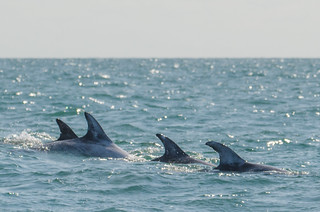 interaction eventually cover the bulk of the body. Older individuals appear mostly white.
interaction eventually cover the bulk of the body. Older individuals appear mostly white.
What a great end to our day!
Our sightings (24) included: carrion crow, chough, common tern, cormorant, fulmar, gannet, great black-backed gull, guillemot, herring gull, jackdaw, kestrel, kittiwake, lesser black-backed gull, linnet, manx shearwater, meadow pipit, oystercatcher, raven, razorbill, rock dove / feral pigeon, shag, stonechat, swallow
and wheatear.
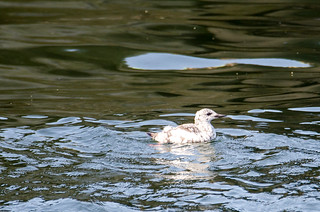 From the end of the garden I did get excited when I saw a black and white bird offshore but when reviewing photos I could see that is was only an eider in eclipse.
From the end of the garden I did get excited when I saw a black and white bird offshore but when reviewing photos I could see that is was only an eider in eclipse.
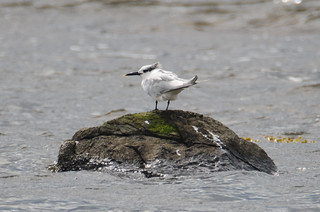 of a single hooded crow [155] - I haven't seen one of these on this part of the coast before.
of a single hooded crow [155] - I haven't seen one of these on this part of the coast before.
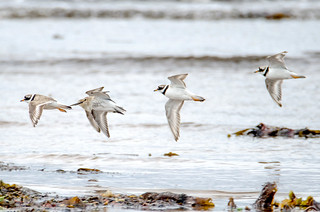 on the shoreline, again joined by a couple of sanderling. Linnet cruised the edge of the golf course as did a small flock of house sparrows.
on the shoreline, again joined by a couple of sanderling. Linnet cruised the edge of the golf course as did a small flock of house sparrows.









